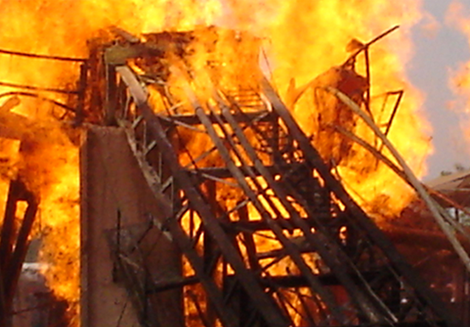Case Study Overview
This well was drilling ahead at a depth of 4100’ with 2000’ of surface casing set. The rig hit a shallow gas zone and took a kick, resulting in a blowout and fire. The well was also producing a large volume of salt water. The drilling crew abandoned the rig and no injuries were sustained during the disaster. The rig and BOP stack were engulfed in flames.
Cudd Well Control (CWC) was contacted to perform the fire fighting and capping operations on the well.

Situation Upon Arrival
The drilling crew was able to remove the mud pumps, pits and other rig components prior to CWC’s arrival on location. Containment berms and water storage pits had been constructed to collect the produced water. The Kelly hose was parted, but there was no flow coming up the drillpipe and there was no float in the drilling BHA.
Intervention Strategy
After gathering the CWC fire fighting equipment, the plan called for removal of the remaining well site debris. The plan required that the rig substructure be removed to gain access to the wellhead, in order to repair or replace the damaged equipment. The well would then be capped and killed. Removal of the substructure debris, without further damaging wellhead integrity and managing the produced water, would pose the greatest obstacles during the recovery operations.
Operations
A cutting shed and heat shields were built to protect the personnel working close to the wellhead. Cuts were made under a protective water spray using exothermic cutting rods. The derrick was cut away from the A-leg supports, the v-door was removed and the internal substructure braces were cut. The rotary beam was cut and the cellar jet was removed. The kelly was cut above the bushings and removed from the rig floor. CWC personnel gained access to the rig floor and pulled the kelly shuck and mouse hole pipe with the crane. The drive bushings were then extracted resulting in purely vertical flow. The well had to be re-ignited and extinguished several times to provide the safest working conditions depending on the type of work being performed at the time. CWC tied onto the substructure with the crawler crane and two bulldozers. The sub was hoisted high enough to clear the BOP stack and then pulled off of the well. The bolts on the bell nipple were severed and the bell nipple stripped over the remaining kelly. At this time it was noticed that the wellhead was damaged during the initial blowout. The damage could not be repaired, so a complete re-head was required. The old head was cut off and an 11” 5M slip-on head was lowered over the flow and secured to the surface casing.

The well was capped with a spacer spool, flow cross, single blind ram and a Venturi tube. The capping stack was nippled up, and an 8 ⅝” diverter line was rigged up to the flow cross outlet. The HCR valve was open and the well was partially diverted to the reserve pit. The pump iron was pressure tested and then the blind rams were closed. CWC began to pump 12.0 ppg kill weight mud down the well and simultaneously shut the HCR valve to proceed with a bullhead kill. A total of 250 barrels of mud were pumped to kill the well. The well was monitored and deamed static. CWC was released from location.